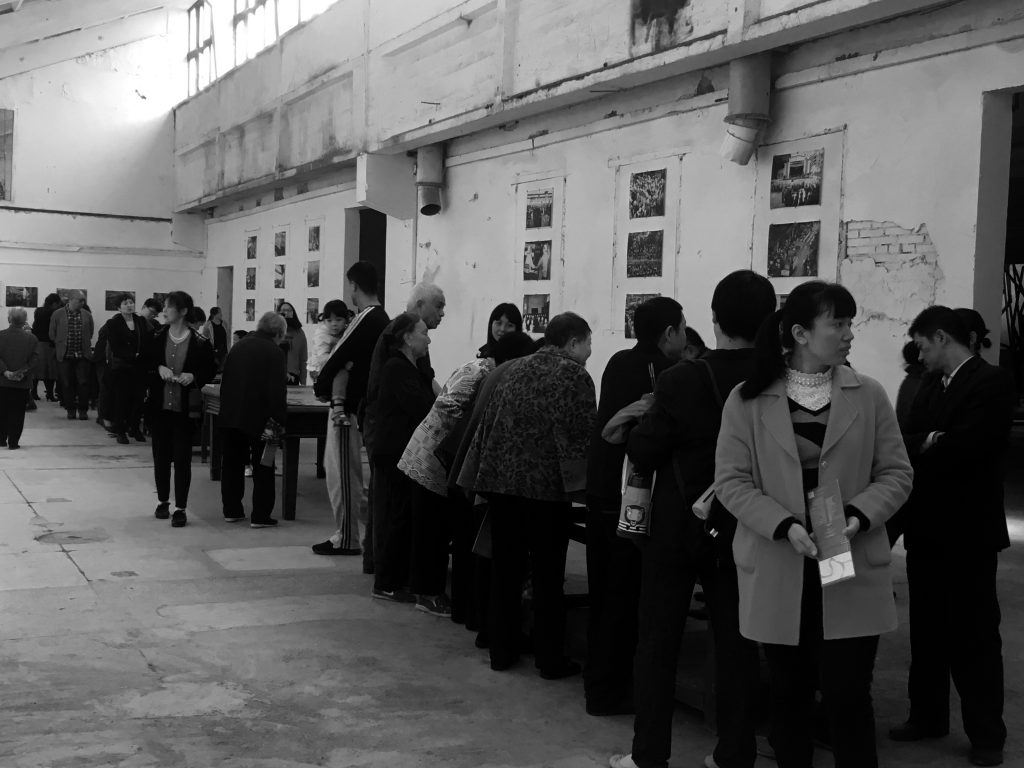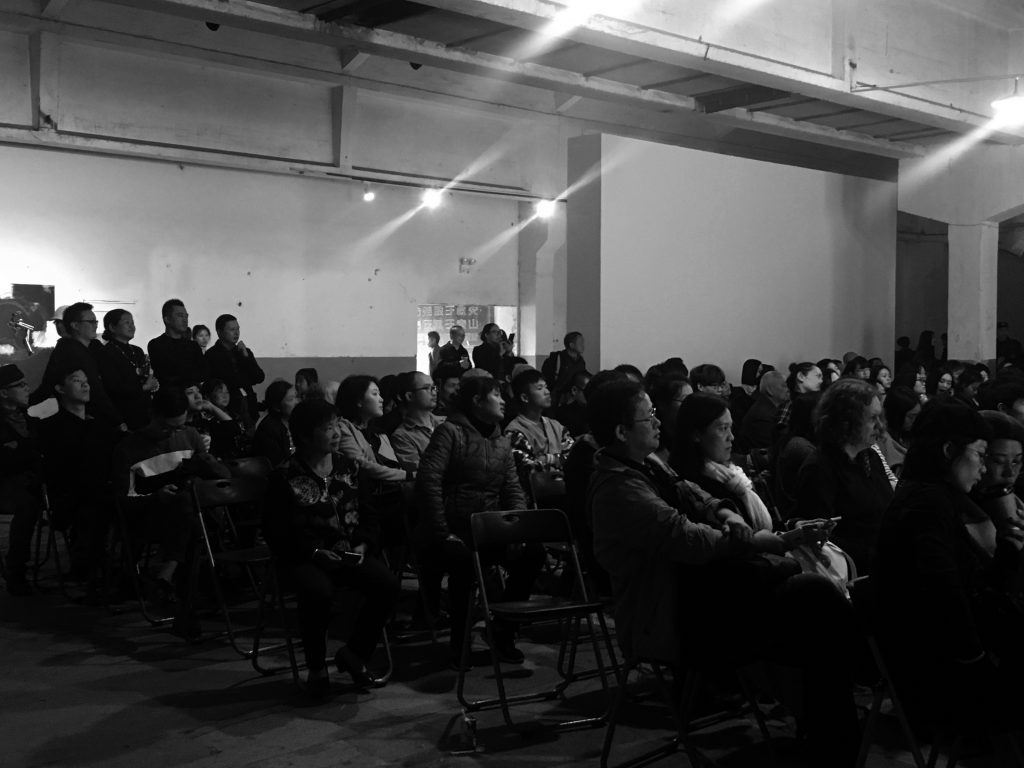Overlapping Heterotopias
First Hechuan Fishing Town International
New Media Arts Festival
An Old Factory: A Dying Heterotopia
Former Chongqing Cotton Mill IV,
Hechuan District, Chongqing
04.11.17 – 04.12.17
Translated by Bridget Noetzel
This is our factory, no one understands it better than us.
– Retired worker, Chongqing Cotton Mill IV
If I hadn’t gone to the first edition of this new international new media arts festival, I would not have had such a strong reaction to the visitors to the exhibitions. People from different cultural backgrounds, despite occupying the same space, could be divided into disparate social realms. Whether we divided them by their ways of thinking or speaking, they were decidedly different. At the opening, there were art people talking about avant-garde art history on stage and people off stage calling to their children to come over and watch the excitement; there were art students absorbed in the photographic works and old workers looking for people they knew in the pictures documenting the factory’s history. Together, they constituted a lively, yet discordant, sight. These seemingly incompatible scenes represented the layering of two different cultural heterotopias.
An Old Factory: A Dying Heterotopia
Chongqing Cotton Mill IV is located in Dongjintuo, Hechuan District, Chongqing. It was once a key element in the Chongqing Textile Industry Department, and the oldest and largest factory in the Dongjintuo area. After the amalgamation of state and private ownership in 1956, Chongqing Cotton Mill IV, like other large state-owned enterprises in China, established a works unit community1 – a form that blended work and life, which was typical of neighbourhood factories, embracing social relationships and a monopolisation of social resources. The factory areas from this period were ‘utopias’ in the national ideology; they met the demands of industrialisation in New China’s early period of urban development, and they also represented the ideal state of socialist economy and culture.
With the reform of the state-owned enterprise system in 1998, workers became part of the market, instead of the leading class who loved their country and protected their works unit, so the communities making up these works units gradually dissolved. The abandoned factories became ghost towns, forsaken by the developing trends of the market economy. They became heterotopias of urban culture. The rather radical slogans in these factories and the ubiquitous portraits of leaders remind us of the past, and the decline of a vanished era. The people who once lived and worked here and their families are living relics of a bygone age, still able to remember the past and recount their memories. They had loved the collective activities, supported the factory system of management, and even retained their fervour for revolution. These old factory areas, impregnated with a lingering atmosphere of the planned economy, reveal the spiritual mainstays of the works unit communities: the working-class leaders and the collectivist spirit. They reflect the ideals of the early social and economic system of the New China, and a history of its vagaries and changes; their existence highlighted the immense upheavals that have taken place in the course of China’s modernisation.
Factories were made obsolete by the process of continual reform and changes to the environment, and changes took place in the thinking and lifestyles of their original inhabitants. The heterotopias of factory culture were dying out, and memories hardened into a static, two-dimensional view of the past. Precisely because of their demise, cultural groups from other spaces now attempt to use their own methods to intervene in these heterotopias of factory culture, by occupying, or ‘reviving’, them.
A New Media Exhibition
Collections in heterotopic museums and libraries are heterotopias that accumulate the relics of different periods and a variety of different objects and themes; here, the continuity of time has been abolished, and replaced with things organised into categories. The motivating force behind museums was the need to establish the primacy of modern Western culture in the nineteenth century. A month-long new media art exhibition is akin to a brief museum-like heterotopia; the different durational and spatial components of a variety of works have been brought together in thematic groupings on the same site, for presentational and didactic effect. Although the exhibition is being held in an old factory, it has been mounted entirely in keeping with the principles of the ‘white cube’: the majority of the works have been separated from their original environment, and displayed in a predetermined setting; some attempt has been made to exhibit works in an open-ended way, but the outcome has been unavoidably influenced by their immediate context and the sequence in which they have been installed.
Of course, this exhibition does not attempt to replicate the standards of display one might expect of an ordinary museum of modern art, and does not seek to set any kind of paradigm, although a sequence of contemporary artworks serves to trigger reflections on society today and throw the marginalisation of culture into sharp relief. The fact of holding this exhibition in Chongqing’s old Cotton Mill IV meant that the organisers were able to transfer the traditional organisational model, with the participation of all the usual factions – the curators, artists, critics, artworks, art media and students – into a different context. The various elements are integrated with one another and come together to constitute a novel artistic assembly. The factory acquires a new cultural identity, imbued with an artistic ambience that generates a heterotopia that references reality. Critical groups built on modernist cultural mechanisms criticise modern society and find it difficult to escape the strictures of modernist ideas, being estranged from, yet also embodying, the modernist spirit.
Open Site: Closed Space
‘There are others [heterotopias], on the contrary, that seem to be pure and simple openings, but that generally hide curious exclusions. Everyone can enter into these heterotopic sites, but in fact that is only an illusion – we think we enter where we are, by the very fact that we enter, excluded.’2 Heterotopias are not defined physical spaces: they are the combination of relatively closed cultural spaces and relationships. Every heterotopia exists in an asynchronous space, where any normal sense of continuity is suspended; heterotopias are composed of some fixed cultural elements and inflexible relationships, governed by a kind of magnetic force and sense of awareness. Precisely because of this, theses heterotopias can coexist in the same space, overlapping yet never alternating with each other.
The two different groups of people in the exhibition appeared to be having their own separate parties in the Chongqing Cotton Mill IV. The former factory workers and their families were warmly reminiscing and finding themselves and people they knew in the old pictures; the art professionals and enthusiasts stopped and reflected in front of the works and then went on to gossip about the latest exhibition news. When asked about the contemporary artworks on show, many of the workers responded: ‘I don’t get it.’ People used to contemporary art exhibitions saw those old pictures merely as documentary material for an artistic manifestation, but they reacted to them in a more emotional way. The conflict between the two notional groups reached a peak at the time of the staged public date about the exhibition. The thematic discussion on the stage was conducted in Chinese and English, while students from art schools and residents from the surrounding neighbourhoods sat off the stage. The local residents resorted to their customary behaviour, when going to an open-air screening, for example, by eating sunflower seeds and talking loudly to their companions. The students showed their displeasure by sighing audibly at the residents making a noise. Each party believed that the other was invading their space.
For different groups, Chongqing Cotton Mill IV constitutes different heterotopic spaces. On the one hand, the factory is a remnant and a symbol of the planned economic system, which has been abandoned during the course of Chinese modernisation and represents a time that can no longer be revisited. On the other, the exhibition was a protest about modern society by the avant-garde art community, examining modern society from a specific distance. The former was China’s first model of socialist modernisation, imbued with a strong political flavour and revolutionary enthusiasm; the latter was a staged experiment, stemming from elite culture and appealing to marginalised groups with an interest in what might happen after modernism. Seen from the outside, both heterotopias might be said to occupy different spaces, but because of the significant cultural differences between the two of them, and their separation from one another, the two groups will find it difficult to achieve a consensus – hence, the creation of overlapping heterotopias.
The Anxiety and Occupation of Space
Michel Foucault believed that many issues in contemporary society stemmed from anxiety about space, and for us, space had epistemological as well as political meaning. High-speed economic development has caused the further expansion of material desires and the contraction of spaces for cultural activities. Therefore, more artistic practices are developing in the countryside, the suburbs and old factories, with the aim of inducing people to participate in local culture and life. These employ a variety of different artistic identities and methods, and exploit them for their value as problematic sites for contemporary art. Both the cultural heterotopias that are characteristic of the disappearing factories and the contemporary art heterotopias that are beginning to emerge are confronted with the spatial anxiety of being hemmed in and taken over.
The countryside, the suburbs and old factories are symbols of ideologies and systems that have been forgotten during the course of modernisation. They are ‘backward’ groups in the linear logic of development, intent on discovering new possibilities for progress and transformation. The invading art groups are both ‘non-mainstream’ groups, distanced from modern society, and those engaged in the expansion of modernism. They embed modernist cultural models in marginal sites, to build new cultural ecosystems. The two are both marginal, looking for a way out; one cannot be completely weakened or subsumed by the other, so they resist one another in the same space. Contemporary art cannot be divorced from the practice of modernist consciousness and models, so it can neither achieve a decentralised state nor blend into a local culture, to realise the complexity and diversity of postmodern culture. Both sides can only immerse themselves in their own cultural heterotopias, continuing to defend themselves and resist the others.
1. In the urban society of the new China of the 1950s, the so-called ‘System of Unit’ ( ‘Danwei’ in Chinese ) was formed nationally. The ‘community unit’ not only established an ambitious historical narrative for the transcendental development of the nation, but also provided the basic social settings that enabled unit members to settle down and get on with their activities.
2. Michel Foucault, ‘Heterotopia’ ( translated by Wang Zhe ), a speech made at a seminar of architectural studies on 14 March 1967.
重叠异托邦
首届中国合川钓鱼城国际新媒体艺术节
重庆市合川区原重棉四厂,重庆
2017 年11 月4 日—2017 年12 月4 日
“这是我们的厂,没有人比我们更了解它”。
——重棉四厂退休工人
如果不去“首届中国合川·钓鱼城国际新媒体艺术节”现场, 我对观展人群之间的差异不会有这么强烈的感受: 不同文化背景的观众,虽处同一场所,却分属于不同的文化“异质空间”。无论是认知系统还是话语系统,都截然不同。开幕现场,台上讨论前卫艺术史的艺术相关人士与台下招呼孩子看热闹的周边居民、专注于影像作品的艺术学院学生与在厂史照片中寻找熟人身影的老工人,一同构成了活泼又失调的场面。这格格不入的现场画面, 是两种不同文化“异托邦”的重叠。
废旧工厂: 正在消亡的异托邦
重棉四厂地处重庆合川东津沱,曾是重庆市纺织工业局所属的骨干企业,也是东津沱地区建得最早、规模最大的工厂。1956 年公私合营以后,重棉四厂像新中国其他大型国有企业一样,建立起一个融生产生活于一体的“单位共同体”1,具有产区社区化、社会关系封闭、社会资源垄断等特点。此时的厂区是国家意识形态的“乌托邦”,一面表明新中国初期城市发展的工业化需求, 一面呈现社会主义经济、文化建设的理想状态。
1998 年,国有企业改制,工人从受国家和单位庇护的领导阶级转变为市场化的劳动者,“单位共同体”渐逐瓦解。废旧厂区如同幽灵一般,被市场经济主导的发展潮流所遗弃。它变为城市文化“异托邦”: 厂区内略显激进的大字标语、随处可见的领导人头像等,提醒着我们一个时代的存在与消亡; 曾在此工作、生活的工人和家属们,更似“活化石”,记忆和诉说着它——他们热爱集体活动、拥护工厂化制度管理,甚至还保留着革命的热情。萦绕着计划经济时代气息的旧厂区,显示了“单位共同体” 的精神支持——工人阶级的领导地位和集体主义精神。它既是新中国初期社会、经济制度建设的理想,又是其探索和改变的历史, 它的存在,更加突显出中国现代化进程所经历的巨大变革。
随着改革的深入,环境的变化,厂区更加萧条,原住民的思维和生活方式发生改变,厂区文化“异托邦”正在消亡——向一 个没有行动力和平面化的纪念性场景转变。也正是因为它的消亡, 来自外部空间的文化群体企图以他们的方式介入厂区文化“异托邦”,占据它或使它“复活”。
新媒体展: 正在聚集的异托邦
博物馆、图书馆是一种积累各类时间、形式和喜好的“异托邦”,在此之中,时间的连续性被废除掉,代之以将一切进行档案归置的行动,而其生成的动力则是19 世纪西方现代文化建立其主体地位的诉求。历时一个月的新媒体艺术展,近似短期的博物馆式“异托邦”,不同作品的时间、空间被并置在同一场所, 形成一个主题性的、有组织的展示、说教空间。尽管展览在旧厂区举办,其展出方式却没有跳脱“白盒子”模式: 大部分作品与其发生的原有情境被分离,观看作品的方式被规定,而部分试图强调开放式展出效果的作品,不可避免受到了布展秩序性和邻近作品的影响。

An Old Factory: A Dying Heterotopia, part of the First Hechuan Fishing Town International New Media Arts Festival, 2018
当然,较之于现代博物馆构建事物标准的意图,此次展览并非为了树立某种典范,而是一次当代艺术的集体逃离,以激发对当下社会的反思和对边缘文化的关注。只是在整个事件的组织和策划中,作为展览空间的重棉四厂,依然遵循了艺术活动的典型运作模式,纳入了艺术“场域”中的诸多构成要素: 策展人、艺术家、批评家、艺术作品、艺术媒体、学生等等,各个要素相互联系并共同构成一个典型“艺术场”。厂区被赋予新的文化身份,注入“艺术气息”,形成一个照见现实的“异托邦”: 建立在现代主义文化机制之上的批判群体,一面对现代社会进行批判,一面又难逃现代主义思想的规训,在疏离的同时亦体现现代主义精神。
开放的场所: 封闭的空间
“一些异托邦看起来完全开放,但通常隐藏了奇怪的排斥。

The opening of the First Hechuan Fishing Town International New Media Arts Festival, 2018. 开幕现场
所有人都可以进入这些异托邦的场所,但这仅仅是一个幻觉。”2 “异 托邦”并非物理空间的定义,而是相对封闭的文化空间和关系集合,每个正在发生作用的“异托邦”都有着与传统时间完全中断的、独有的共时性,它们由一些固定的文化要素和不可伸缩的关系所构成,亦受到某种中心权力和知识的规训。正因如此,它们可以存在于同一场所,重叠但不可迭和。
同时出现在重棉四厂的两个不同人群,都在进行着他们的“派对”: 厂区工人和家属们在厂史陈列区热络地叙旧、在旧照片里寻找自己和熟人的身影; 艺术从业者和爱好者在作品前驻足、思考,与人谈论近期的展讯。被问及展出的当代艺术作品时,工人们的回答多是“不懂”; 而对习惯了当代艺术展览模式的人来说, 那些老照片不过是此次艺术项目的文献资料,并无更多情感色彩。二者之间的矛盾在展览的论坛现场达到顶峰: 台上进行着中英双语的专题讨论,台下分坐着艺术院校的学生和周边的居民,居民们保留以往观看露天电影的习惯——吃瓜子、大声招呼同伴,而学生们则对居民的聒噪还以深重的叹息,以示不满,双方都认为对方是这个空间的侵入者。
对于不同人群来说,重棉四厂构成不同的“异托邦”空间: 一方面,它是计划经济体制的残余和象征,在中国的现代化进程中被摒弃,是不可重返的时代情境; 另一方面,它又是前卫艺术群体对现代社会的抗议,与现代社会保持距离并进行审视。前者是中国“社会主义现代化”初期模式,充满政治色彩与革命激情; 后者是“现代主义之后”探寻的方案,发源于“精英文化”又诉诸边缘人群。二者均异于外部空间,又因巨大的文化差别和各自的封闭性,彼此之间难以达成共识,因之造就了“重叠异托邦” 的景象。
空间的焦虑与侵占
福柯认为当代社会的许多问题都源自空间焦虑,空间对于我们来说,不仅具有认识论意义,而且具有政治意义。高速的经济发展导致了物欲的进一步扩张和文化活动空间的收缩,于是越来越多的艺术实践意图在乡村、城郊和废旧厂区开展,期望以艺术的身份和方式参与到当地文化、生活中去,将之作为当代艺术的问题现场。而无论是正在消亡的厂区文化“异托邦”还是正在聚集的当代艺术“异托邦”,它们都面临着被挤压和侵占的空间焦虑。
乡村、城郊和废旧厂区多是现代化进程中被遗忘的意识形态和体制象征,属线性发展逻辑中的“落后”群体,它们努力寻找进步和改造的可能性; 而正在入侵的艺术群体,一面是现代社会中逃离的“非主流”群体,一面又进行着现代主义的扩张——将现代主义文化模式嵌入边缘场景之中,建立新的文化生态。二者皆属“边缘”,都在寻求出路,也都无法完全被对方侵蚀和吞并, 便在同一场所中展开了对抗。而就当代艺术来说,没有脱离现代主义意识与模式的实践,无法达到“去中心化”的状态,也便无法与在地文化融通,实现“后现代”文化所描述的混杂、多元。双方只能各自沉浸在各自的文化“异托邦”之中,继续自卫与抗争。
1.20 世纪50 年代,新中国的城市社会形成了“举国一致”的“单位体制”,“单位共同体”是国家赶超式发展的宏大历史叙事,也是单位成员“安身立命”的基本社会设置。
2.【法】米歇尔·福柯《异托邦》,福柯于1967 年3 月14 日在建筑研究会上的讲演,王喆译。